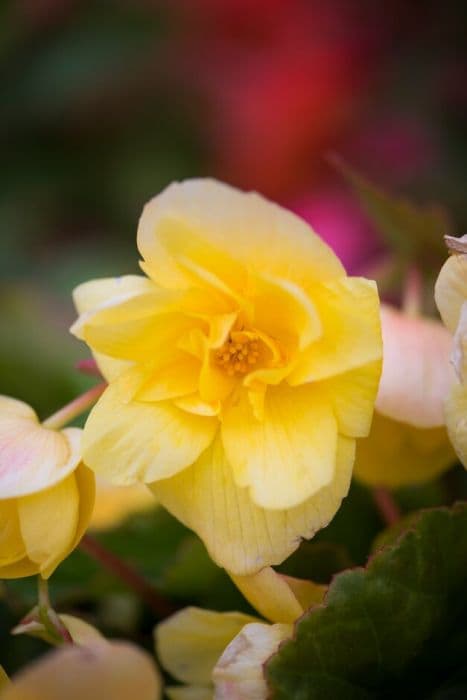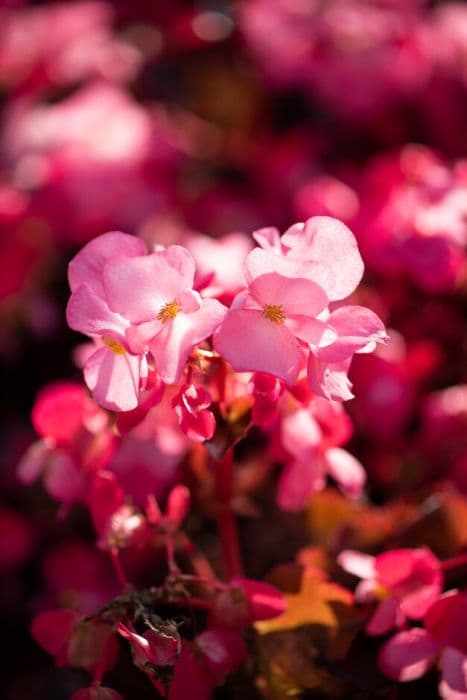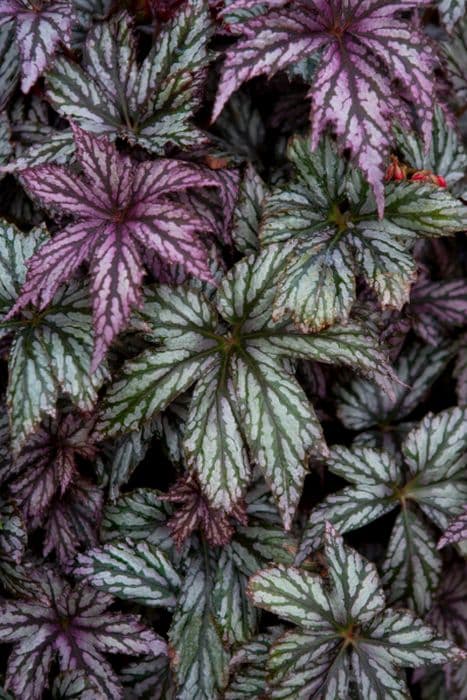Emerald Beauty Begonia Begonia 'Emerald Beauty' (R)

ABOUT
Begonia 'Emerald Beauty' is a striking ornamental plant known for its lush and vibrant foliage. The leaves of this begonia are its most remarkable feature, boasting a rich emerald green hue that instantly catches the eye. Each leaf is glossy and somewhat fleshy, presenting a luxurious, robust appearance. The leaf shape is quite distinctive, with some having elegant pointed tips that may gently wave, contributing to the plant's overall graceful aesthetic. These leaves often have a bold, asymmetric heart shape that adds to their visual interest. The surface of the leaves can be textured with subtle veining, adding depth and character to the foliage. Reflective of its name, 'Emerald Beauty' shines with a jewel-like quality, and its leaves can sometimes appear to shimmer slightly in the light, thanks to their glossy finish. Depending on the level of light the plant receives, the leaves may also exhibit subtle patterns or variations in green intensity, which further enhances the dynamic look of the plant. Although we are not discussing size, Begonia 'Emerald Beauty' is typically prized for its verdant display rather than its flowers. The blooms, if present, are usually less showy and take a back seat to the magnificent leaves. The stems of 'Emerald Beauty' maintain a modest profile, supporting the foliage and blending seamlessly into the overall presentation of the plant, without drawing attention away from the spectacular leaves. The overall aesthetic of Begonia 'Emerald Beauty' is one that exudes a lush and exotic charm, making it a popular choice for adding a touch of tropical elegance to interior spaces or shaded garden areas.
About this plant
 Names
NamesFamily
Begoniaceae
Synonyms
Emerald Beauty Begonia
Common names
Begonia 'Emerald Beauty'
 Toxicity
ToxicityTo humans
Begonias are generally considered non-lethal to humans, but they can be irritating if ingested. The most common symptoms of ingestion include a burning sensation in the mouth, throat, and lips, as well as potential swelling of the oral tissues which could lead to difficulty swallowing. Additionally, there can be gastrointestinal discomfort such as nausea, vomiting, or diarrhea. Contact with the sap may also cause skin irritation or rash. It is important to keep begonias out of reach of children who may be tempted to chew on the attractive leaves or stems.
To pets
Begonias are known to be toxic to pets, particularly dogs and cats. If a pet ingests any part of the plant, it can experience symptoms such as vomiting, diarrhea, and salivation. There is also a potential for irritation of the mouth and throat leading to difficulty swallowing and a burning sensation. In severe cases, ingestion could lead to kidney failure or other serious health issues. It is crucial to ensure pets do not have access to begonias and to consult a veterinarian immediately if ingestion is suspected.
 Characteristics
CharacteristicsLife cycle
Perennials
Foliage type
Evergreen
Color of leaves
Green
Flower color
Pink
Height
1-2 feet (30-60 cm)
Spread
1-2 feet (30-60 cm)
Plant type
Herb
Hardiness zones
10
Native area
Central and South America
Benefits
 General Benefits
General Benefits- Ornamental Appeal: Adds aesthetic value to indoor and outdoor spaces with its lush, green foliage and unique leaf patterns.
- Easy Maintenance: Typically requires low care, making it suitable for novice gardeners or those with a busy lifestyle.
- Humidity Tolerance: Thrives in humid environments, which can make it an ideal plant for terrariums or bathrooms.
- Versatile Placement: Can be grown in a variety of settings, from hanging baskets to standard pots, allowing for creative decor implementations.
- Seasonal Interest: Some varieties may produce delicate flowers, adding seasonal charm to the plant's display.
- Non-Toxicity: Safe to keep around pets and children, as it does not contain harmful toxins.
- Shade Tolerance: Performs well in low-light conditions where other plants might struggle.
- Mood Enhancement: Contributes to a pleasant and relaxing environment, which can be beneficial for mental well-being.
 Medical Properties
Medical PropertiesThis plant is not used for medical purposes.
 Air-purifying Qualities
Air-purifying QualitiesThis plant is not specifically known for air purifying qualities.
 Other Uses
Other Uses- Begonias, like the 'Emerald Beauty', can be used in terrariums due to their preference for high humidity and their vibrant foliage adding aesthetic appeal to the enclosed ecosystem.
- The waxy and colorful leaves of Begonia 'Emerald Beauty' can be used in floral arrangements to add a tropical flair and textural contrast.
- Begonia leaves, particularly the larger varieties, can be used as natural molds for garden stepping stones, creating unique and ornate pathways.
- 'Emerald Beauty' Begonia can be a subject for botanical illustration and photography, providing a vibrant subject matter due to its lush green leaves.
- The plant can serve as a living educational tool to teach about plant propagation, as Begonias can be easily propagated from leaf cuttings.
- In frost-free regions, Begonias like 'Emerald Beauty' are used as ground cover, providing a dense carpet of greenery throughout the year.
- Its compatibility with shaded environments makes 'Emerald Beauty' suitable for under-planting beneath taller plants or trees in a layered garden design.
- The contrasting green foliage of 'Emerald Beauty' can be used to accentuate the colors of flowering plants when placed in close proximity in a garden bed or container.
- Begonia 'Emerald Beauty' can be used in sensory gardens for visually impaired individuals, as its unique leaf texture provides a tactile experience.
- During festive seasons, particularly Christmas, the green leaves of 'Emerald Beauty' can be arranged with red flowers to create natural decorations consistent with traditional holiday color themes.
Interesting Facts
 Feng Shui
Feng ShuiThe Emerald Beauty Begonia is not used in Feng Shui practice.
 Zodiac Sign Compitability
Zodiac Sign CompitabilityThe Emerald Beauty Begonia is not used in astrology practice.
 Plant Symbolism
Plant Symbolism- Caution: Begonia is often associated with a sign of caution or warning. The 'Emerald Beauty' variety, with its rich and vibrant green, might signify the importance of proceeding carefully or being aware of one's surroundings.
- Harmony: The lush green of the 'Emerald Beauty' can symbolize harmony and balance, suggesting a need for tranquility and peace in one's life.
- Individuality: Begonias typically represent individuality and uniqueness. The 'Emerald Beauty' Begonia, with its distinctive appearance, can be a reminder to stay true to oneself.
- Gratitude: Giving a Begonia like the 'Emerald Beauty' can be an expression of gratitude or appreciation for someone's friendship or efforts.
 Water
WaterBegonias, including the 'Emerald Beauty', should be watered when the top inch of soil feels dry to the touch. It is important to water this plant thoroughly until water runs out of the bottom of the pot, which could mean using about half a gallon for a medium-sized pot every week or two, depending on the environment. Overwatering can lead to root rot, so it's crucial not to let the Begonia sit in water. The frequency of watering will vary with temperature and humidity, but generally, Begonias prefer a consistent schedule. Allow the soil to dry slightly between waterings, usually every 7 to 10 days.
 Light
LightThe Begonia 'Emerald Beauty' thrives in bright, indirect light. It prefers a spot that receives plenty of light without being exposed directly to the harsh rays of the sun, such as near a window with sheer curtains. An east-facing or north-facing window is ideal. Too much direct sunlight can scorch the leaves, while too little light can cause leggy growth.
 Temperature
TemperatureThe ideal temperature range for Begonia 'Emerald Beauty' is between 60 and 75 degrees Fahrenheit. It should not be exposed to temperatures below 50 degrees Fahrenheit, as this can cause damage to the plant. Begonias generally do not tolerate extreme heat or cold well, so they should be kept away from drafts and heating vents.
 Pruning
PruningPruning the Begonia 'Emerald Beauty' helps to maintain its shape and encourage fuller growth. It is best to prune or pinch back the tips of the plant during the growing season, spring through summer, to promote branching. Remove any dead or yellowing leaves as they appear to keep the plant healthy. Pruning should be done carefully with clean, sharp scissors or pruning shears.
 Cleaning
CleaningAs needed
 Soil
SoilFor Begonia 'Emerald Beauty', a well-draining soil mix that includes peat moss, perlite, and pine bark is ideal, with a soil pH ranging from slightly acidic to neutral, around 5.5 to 6.5.
 Repotting
RepottingBegonia 'Emerald Beauty' should be repotted once every 1-2 years, typically when the plant becomes root-bound or the soil quality deteriorates.
 Humidity & Misting
Humidity & MistingBegonia 'Emerald Beauty' thrives in high humidity levels, ideally between 50-70%.
 Suitable locations
Suitable locationsIndoor
Place in bright, indirect light and keep soil moist.
Outdoor
Grow in dappled shade, protect from harsh elements.
Hardiness zone
10-11 USDA
 Life cycle
Life cycle'Emerald Beauty' Begonia, also known as 'Emerald Beauty' Wax Begonia, begins its life cycle when seeds are sown in a well-draining soil mix, typically in a warm and moist environment to encourage germination. After germination, seedlings develop true leaves and roots, marking the vegetative growth stage where they should be provided with bright, indirect light and kept consistently moist. When mature enough, they are transplanted to larger pots or outdoor beds, where they continue to grow, developing a bushy foliage of shiny, emerald green leaves and numerous clusters of delicate flowers. The plant reaches maturity and enters the flowering stage during the warmer months, producing either white, pink, or red blossoms, depending on the variety. During the end of its annual cycle, if it is not a perennial in the local climate, it may produce seed pods which can be harvested before the plant dies back with the first frost. Perennial Begonias will enter dormancy during the cold season, retreating to the rhizome or tuber to survive until the next warm season, when the cycle starts again with new growth.
 Propogation
PropogationPropogation time
Spring-Early Summer
Propogation: Begonia 'Emerald Beauty' is best propagated during the warmer months of spring and summer when the plant is actively growing. The most popular method for propagating this plant is by stem cuttings. To propagate the Begonia 'Emerald Beauty' using stem cuttings, a healthy stem with a few leaves should be chosen. Cut a 4 inch (approximately 10 cm) section of the stem just below a node, where leaves emerge. The lower leaves of the cutting should be removed, leaving one or two at the top. The cut end of the stem can be dipped in rooting hormone to encourage root growth, though this is optional. The stem cutting can then be placed in a moist potting mix or water, ensuring at least one node is submerged for roots to develop. Rooting typically occurs within a few weeks, after which the new plant can be potted up and gradually acclimated to normal growing conditions.





![Begonia [Devotion]](/_next/image?url=https%3A%2F%2Fplants-admin.emdemapps.com%2Fimages%2Fplants%2F%2Fimages%2F604b58183573b.png&w=640&q=75)



![Begonia [Fragrant Falls Orange]](/_next/image?url=https%3A%2F%2Fplants-admin.emdemapps.com%2Fimages%2Fplants%2F%2Fimages%2F604b537c1a26c.png&w=640&q=75)